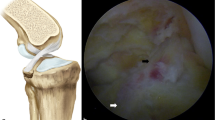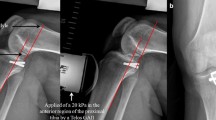Abstract
This paper reports the clinical outcome of the arthroscopic reduction and pull-out suture technique in acute and chronic displaced tibial spine anterior cruciate ligament (ACL) avulsion fractures. Between April 1997 and December 2000, 14 patients received an arthroscopic reduction and pull-out suturing of displaced tibial spine fractures (ACL avulsion fractures of tibia). Of 14 cases, ten were acute fractures and four were chronic nonunion fractures, in which all patients showed extension limitation. The mean follow-up period was 51 months (ranging from 30 to 80 months). At final follow-up, review of range of motion, Lachman test, anterior drawer test, KT-2000 arthrometer, Lysholm knee score, and Hospital for Special Surgery (HSS) score were evaluated. Compared to conventional pull-out suturing, several key modifications to surgical techniques were used. In all 14 patients, radiological bony union was detected at mean 12.3 weeks (range, 8–16 weeks) after surgery. All patients were able to return to their preinjury activity and sports level. At final follow-up, full range of motion was achieved in all patients. Anterior draw test, Lachman test, and KT-2000 (less than 3 mm side-to-side) were all negative in 13 patients. One female patient, who was 6 years old at the time of surgery, complained of no subjective instability, but showed Lachman grade I, and 5 mm side-to-side difference in KT-2000. She also revealed 10°̇ difference of genu recurvatum deformity. Two children (including the previously-mentioned 6-year-old female patient) showed leg-length discrepancy of 1 cm—the affected legs being longer—at final follow-up. The mean Lysholm knee scores were 95.6 (range, 92–100) and HSS knee scores were 96.4 (range, 91–100). Arthroscopic reduction with modified pull-out suturing technique in displaced tibial spine ACL avulsion fractures showed excellent union rate for both acute and chronic cases, without instability or extension limitations at minimum two-year follow-up.




Similar content being viewed by others
References
Baxter MP, Wiley JJ (1988) Fractures of the tibial spine in children. An evaluation of knee stability. J Bone Joint Surg Br 70:228–230
Berg EE (1995) Pediatric tibial eminence fractures: arthroscopic cannulated screw fixation. Arthroscopy 11:328–331
Binnet MS, Gurkan I, Yilmaz C, Karakas A, Cetin C (2001) Arthroscopic fixation of intercondylar eminence fractures using a 4-portal technique. Arthroscopy 17:450–460
Davies EM, McLaren MI (2001) Type III tibial spine avulsions treated with arthroscopic Acutrak screw reattachment. Clin Orthop 388:205–208
Eilert RE (1978) Arthroscopy and arthrography in children and adolescent. In: AAOS symposium on arthroscopy and arthrography of the knee. Mosby, St Louis, p 12
Janarv PM, Hirsch G (2001) Growth influences knee laxity after anterior tibial spine fracture: a study on rabbits. Acta Orthop Scand 72:173–180
Jung YB, Yum JK, Koo BH (1999) A new method for arthroscopic treatment of tibial eminence fractures with eyed Steinmann pins. Arthroscopy 15:672–675
Kim SH, Ha KI (2000) The SMC knot—a new slip knot with locking mechanism. Arthroscopy 16:563–565
Kocher MS, Foreman ES, Micheli LJ (2003) Laxity and functional outcome after arthroscopic reduction and internal fixation of displaced tibial spine fractures in children. Arthroscopy 19:1085–1090
Kogan MG, Marks P, Amendola A (1997) Technique for arthroscopic suture fixation of displaced tibial intercondylar eminence fractures. Arthroscopy 13:301–306
van Loon T, Marti RK (1991) A fracture of the intercondylar eminence of the tibia treated by arthroscopic fixation. Arthroscopy 7:385–388
Lubowitz JH, Grauer JD (1993) Arthroscopic treatment of anterior cruciate ligament avulsion. Clin Orthop 294:242–246
Mah JY, Otsuka NY, McLean J (1996) An arthroscopic technique for the reduction and fixation of tibial-eminence fractures. J Pediatr Orthop 16:119–121
Mah JY, Adili A, Otsuka NY, Ogilvie R (1998) Follow-up study of arthroscopic reduction and fixation of type III tibial-eminence fractures. J Pediatr Orthop 18:475–477
Matthews DE, Geissler WB (1994) Arthroscopic suture fixation of displaced tibial eminence fractures. Arthroscopy 10:418–423
McLennan JG (1982) The role of arthroscopic surgery in the treatment of fractures of the intercondylar eminence of the tibia. J Bone Joint Surg Br 64:477–480
McLennan JG (1995) Lessons learned after second-look arthroscopy in type III fractures of the tibial spine. J Pediatr Orthop 15:59–62
Meyers MH, McKeever FM (1970) Fracture of the intercondylar eminence of the tibia. J Bone Joint Surg Am 52:1677–1684
Mylle J, Reynders P, Broos P (1993) Transepiphysial fixation of anterior cruciate avulsion in a child. Report of a complication and review of the literature. Arch Orthop Trauma Surg 112:101–103
Osti L, Merlo F, Bocchi L (1997) Our experience in the arthroscopic treatment of fracture-avulsion of the tibial spine. Chir Organi Mov 82:295–299
Panni AS, Milano G, Tartarone M, Fabbriciani C (1998) Arthroscopic treatment of malunited and nonunited avulsion fractures of the anterior tibial spine. Arthroscopy 14:233–240
Prince AR, Moyer RA (1995) Arthroscopic treatment of an avulsion fracture of the intercondylar eminence of the tibia. Case report. Am J Knee Surg 8:114–116
Zaricznyj B (1977) Avulsion fracture of the tibial eminence: treatment by open reduction and pinning. J Bone Joint Surg Am 59:1111–1114
Author information
Authors and Affiliations
Corresponding author
Rights and permissions
About this article
Cite this article
Ahn, J.H., Yoo, J.C. Clinical outcome of arthroscopic reduction and suture for displaced acute and chronic tibial spine fractures. Knee Surg Sports Traumatol Arthrosc 13, 116–121 (2005). https://doi.org/10.1007/s00167-004-0540-6
Received:
Accepted:
Published:
Issue Date:
DOI: https://doi.org/10.1007/s00167-004-0540-6




